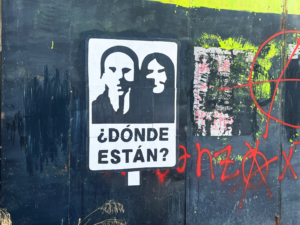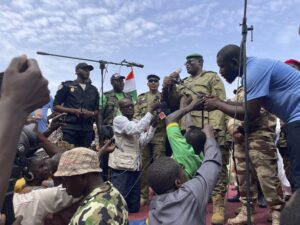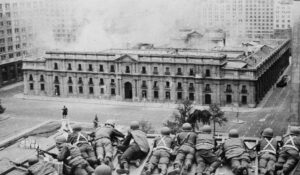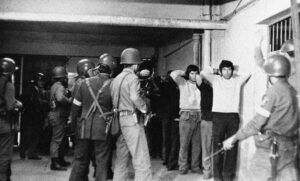Thousands of Peruvians Defy Police Violence to Protest Coup
Protesters called for Dina Boluarte’s resignation, the closure of the right-wing controlled Congress, and Pedro Castillo’s release. Protests in Lima against Dina Boluarte Mayimbú
via Wikimedia Commons / CC BY-SA 3.0
Protests in Lima against Dina Boluarte Mayimbú
via Wikimedia Commons / CC BY-SA 3.0
Tens of thousands of Peruvians took to the streets across the country on July 19 to protest the Dina Boluarte coup government. Boluarte assumed the presidency in December following a legislative coup against leftist President Pedro Castillo — who remains in “preventative detention” — after making an alliance with right-wing parties in Congress.
Thousands marched to the capital — the third Toma de Lima (Takeover of Lima) since Castillo was ousted — marking the first of 10 days of national action called for by unions and grassroots organisations until Peru’s Independence Day on July 28.
Protesters called for Boluarte’s resignation, the closure of the right-wing controlled Congress, Castillo’s release and a constituent assembly to draft a new constitution.
Students took over the National University of Huancavelica in protest against Boluarte and Congress. Congress, controlled by the right-wing alliance, has an approval rating of just 6%.
Congress, controlled by the right-wing alliance, has an approval rating of just 6%.
Protesters blockaded roads in the regions of Loreto, La Libertad, Ayacucho and Huancavelica.
About 24,000 police were deployed across the country and violently attacked many of the peaceful protests.
Police fired tear gas into crowds of protesters in Lima, causing serious injuries. Police harassed, beat up and arrested Indigenous Aymara women during protests on July 22.
Police and the military have killed at least 70 people and injured hundreds since protests began in December. An Inter-American Commission on Human Rights report, released in May, documented “disproportionate, indiscriminate and lethal use of force” against protesters. The police and military committed “extrajudicial executions” and “massacres” in some cases, the report said.
Meanwhile, popular support for the protests has grown. A recent survey by the Institute of Peruvian Studies found that 58% of people identified with the demands of the anti-government protests — up from 50% in January.
Despite the best efforts of the corporate-owned media to manufacture support for the Boluarte regime, it has been overwhelmingly rejected. A CPI Research poll this month found more than 80% surveyed reject the Boluarte government. This figure is nearly 90% in Peru’s interior — historically the poorest and marginalised regions.
However, the United States continues to support the coup government, despite its widespread human rights abuses and condemnation from within Peru and elsewhere.
The US government played a nefarious role in the ousting of Castillo. US ambassador to Peru Lisa Kenna — a former CIA agent with a long history of meddling in the affairs of other countries on behalf of the US — met with Peru’s defence minister the day before the coup. The same minister subsequently ordered the army to turn on Castillo.
Concerningly, Peru’s Congress passed a resolution in May allowing about 1000 US troops, along with weapons and equipment, to enter the country and stay until the end of the year.
Concerningly, Peru’s Congress passed a resolution in May allowing about 1000 US troops, along with weapons and equipment, to enter the country and stay until the end of the year, reinforcing US imperialism’s role in the region. The US troops will train the Peruvian military and police in further repression.
The Communist Party of Peru condemned the decision in a statement. Deputy Secretary-general Arturo Ayala Del Río said the entry of US troops “is an affront to our sovereignty and an explicit endorsement by the US government of the nefarious regime of Dina Boluarte, [which is] responsible for the repression against Peruvian people”.
Ayala Del Río said the decision to carry out a military exercise in Peru’s southern regions, where the army and police carried out their most brutal repression against the people, is a “gesture of contempt for the pain of dozens of families who are still mourning their losses”.
“It is also a sign of the United States’ interest in our resources, water and minerals, which are of strategic importance in today’s troubled world.”
Your support matters…Independent journalism is under threat and overshadowed by heavily funded mainstream media.
You can help level the playing field. Become a member.
Your tax-deductible contribution keeps us digging beneath the headlines to give you thought-provoking, investigative reporting and analysis that unearths what's really happening- without compromise.
Give today to support our courageous, independent journalists.





You need to be a supporter to comment.
There are currently no responses to this article.
Be the first to respond.